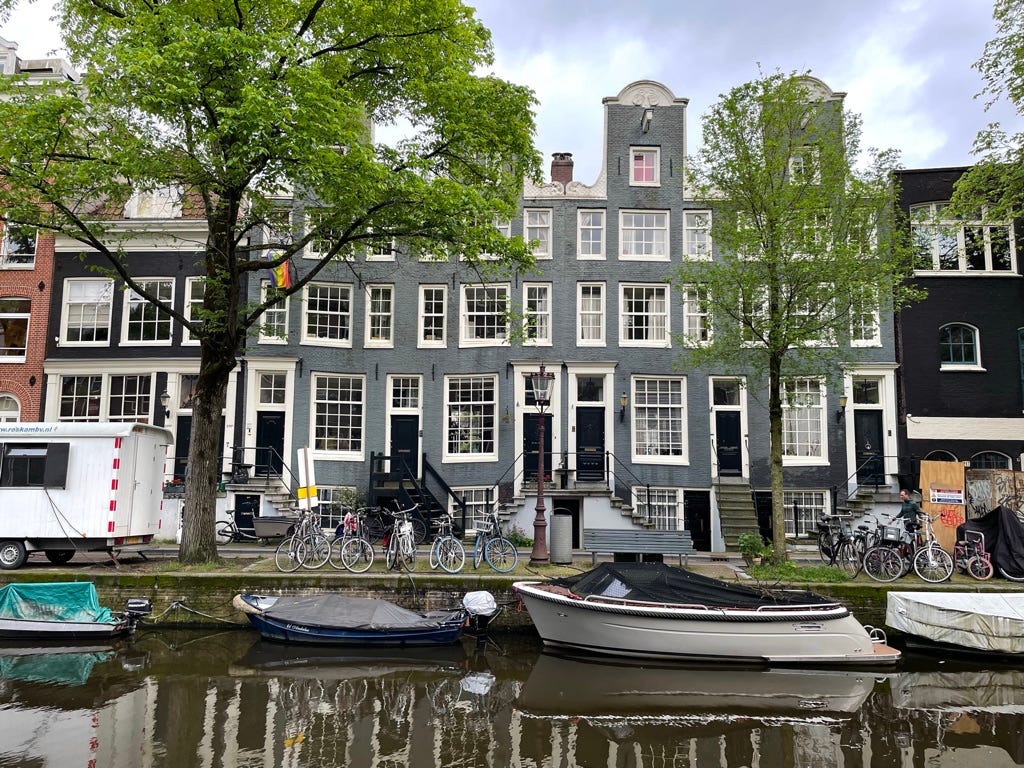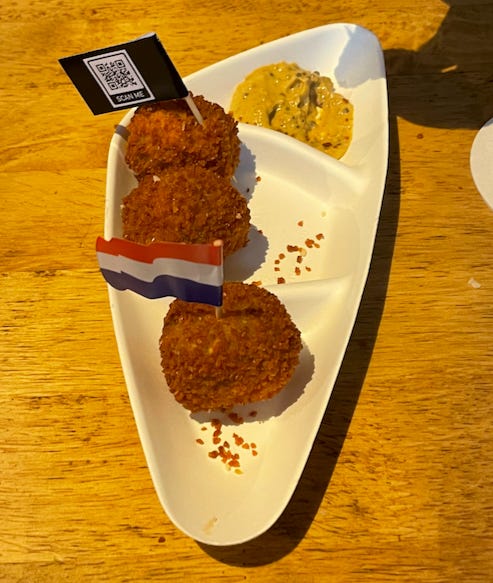My itinerary: Amsterdam, Maastricht, Cologne day trip, quick stop in Brussels, Antwerp, then Gent (all too briefly).
Buildings
If you love gentle density you will love Amsterdam. There are miles and miles of city streets like this:
There wasn’t much architectural variation across the city though — if you walked around for a while you definitely had the feeling, rightly or wrongly, that it was all kind of the same. Edinburgh, though beautiful, is a bit like this too.
Cologne was similarly uniform, except the buildings there are much more drab, and at times ugly. The city was completely flattened by RAF bombs in WWII and rebuilt afterwards.
Perhaps few cities can match the architectural variety of London? Antwerp might come close. Happily, it is willing to build a large block of apartments or offices in the middle of the city, even adjoining more traditional buildings. The pale colours somehow make me think of Miami or maybe Beirut.
Cycling
Dutch people love to cycle — crossing the street is a great test for your peripheral vision. However, in Amsterdam in particular, it was far from obvious where people were actually cycling to. There is no central business district, and the low density distributed housing means that there aren’t even any obvious office blocks. The ratio of people outdoors to indoors was never quite right; there were always more people cycling than the busyness of shops and restaurants would imply. Perhaps young idle Dutch are paid to cycle around the city and make it look bustling for tourists…
My casual impression was that Dutch people tended to be quite fit and healthy; there were few overweight people. When you actually look at the statistics, though, Dutch people are not actually significantly less obese than British people (29% in the UK vs 23% in the Netherlands), and both countries are on a similar trend line.1
Energy
Rooftop solar panels seemed pretty well deployed in the Netherlands, easily spotted on farm roofs. Around 20% of households (1.5m of 8m) in the country have solar panels, and the Dutch are rolling it out rapidly. Belgium lags somewhat with 7% of households, but the UK is a rather poor 3-4% of households. Latitude does matter of course, but much of southern England has similar irradiation to the Netherlands:
However, it was on wind that Belgium really put the UK to shame. Antwerp has a riverfront which is absolutely dominated on one side by a wind farm:
Clearly they don’t see this as incompatible with the city being pretty or liveable; they are redeveloping a section of the waterfront which is well in view of the turbines. The port’s history and economic importance (Europe’s second largest container port after Rotterdam) may help its case here.
The contrast with the UK is stark. New wind turbines are de facto illegal in England, and it’s scarcely imaginable that a bunch could be built so close to a city. ‘Landscape and visual impact’ concerns can be used by local governments (or even lone individuals) to kill projects.
Walk further down the river and you’ll see various other port industries, including a gas flare on the far left:
Dan Wang has written on how China’s strong emphasis on the physical aspects of technology are in sharp contrast to the West, where social media companies rule and the lived environment has largely stopped changing. New skylines in the UK would be one indication that its economic prospects are improving.
Misc.
A tour of the underground fortifications in Maastricht was a particular highlight. I’ve been to plenty of medieval castles and Roman sites, but I can’t recall visiting anything from the Napoleonic era. Wandering through the actual structures from the 18th century is pretty cool.
Also recommended:
Cycling from Maastricht to Valkenburg
Walking around the Jewish district of Antwerp. A window into what many parts of Europe were like before WWII. The main industry is diamonds, and there is clearly some inter-ethnic competition with newly arrived Indian jewellers.
Cologne Cathedral. Took six centuries to complete.
Antwerp’s Royal Museum of Fine Arts (recently renovated). Organised by theme. The Brueghel paintings are particularly good.
Food
For some reason Australian ice cream seems to be very popular in Belgium?
The most exotic food I had was rijsttafel, a colonial Dutch dish made up of multiple small dishes:
Belgian and Dutch food is broadly similar to British food: lots of potatoes, beef, root vegetables. I was particularly intrigued by bitterballen, essentially lumps of stew that are refrigerated, rolled into balls and fried.
Croquettes mashed into bread were also very nice (if not very aesthetically pleasing):
There has to be an opportunity to bring these to the UK and Ireland. It’s hearty food that you might enjoy on a winter’s day, and it’s not really that different from what British/Irish people are used to. Bitterballen could be rebranded as ‘deep fried Irish stew’…
h/t Sam Enright.













Australian ice cream is a Belgian chain of icecream parlours., named in honour of the founder's Australian godmother, who made the first outside investment in the enterprise.
Anyway, I wrote some blogposts about Dutch culture and history that you might find interesting.
https://henkb.substack.com/p/wooden-shoes-and-marihuana
(BTW. i found your blog through Sam Enrights blogroll)